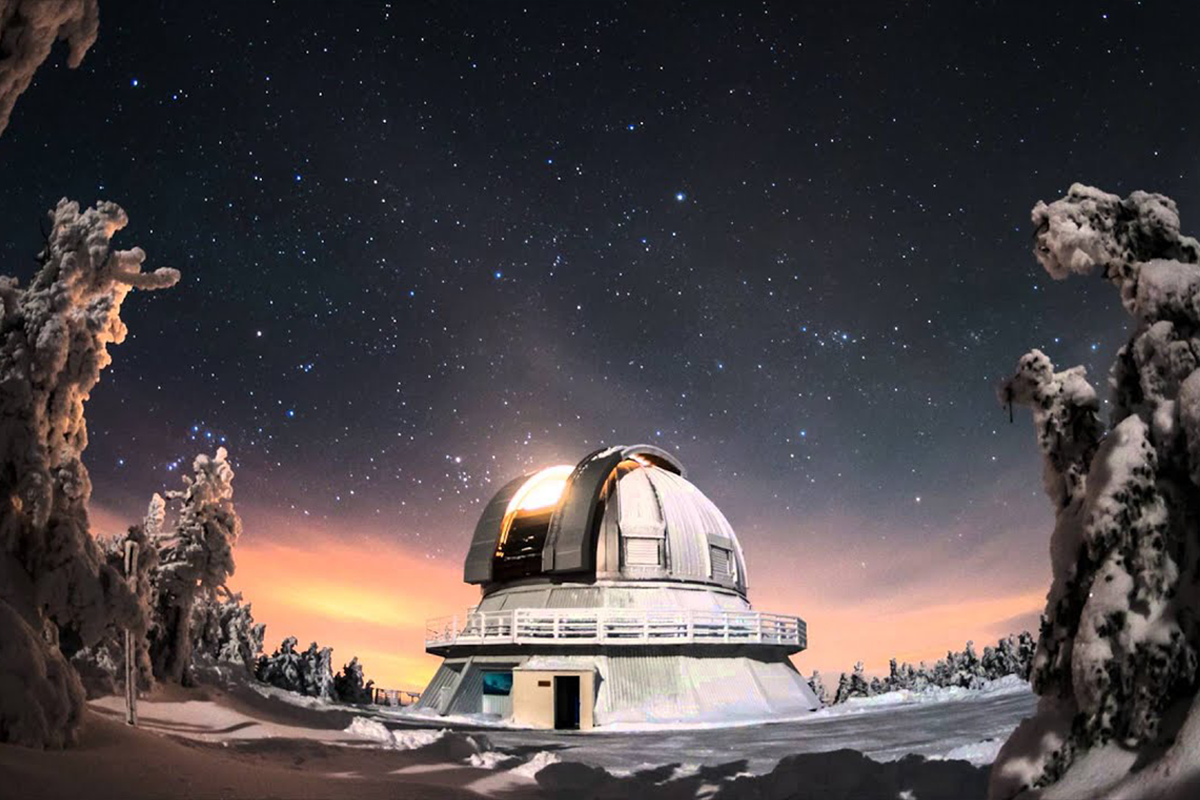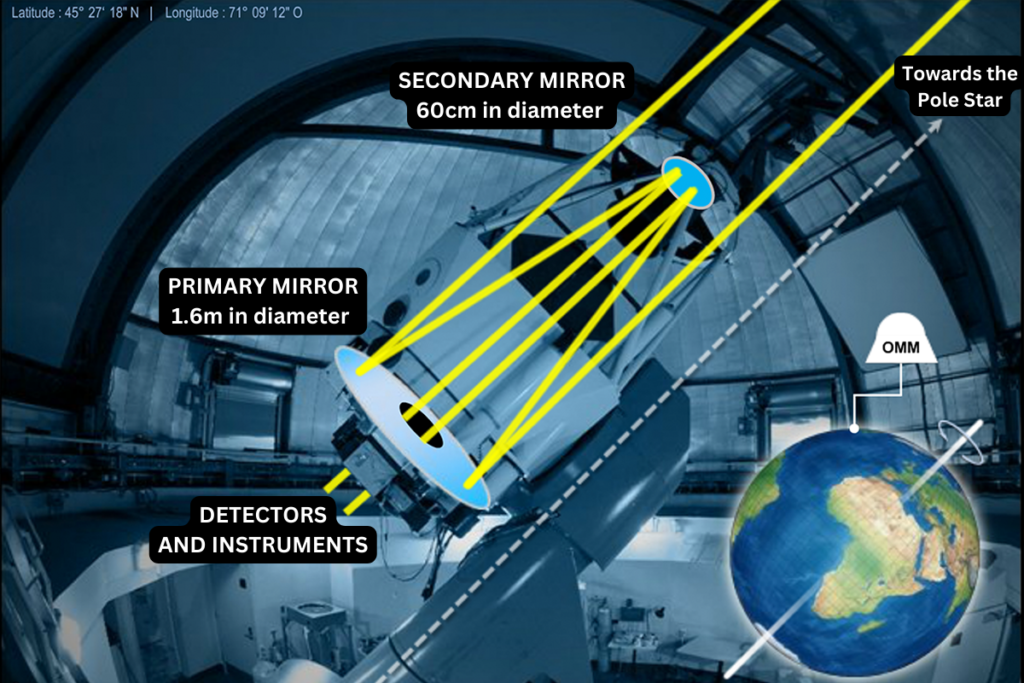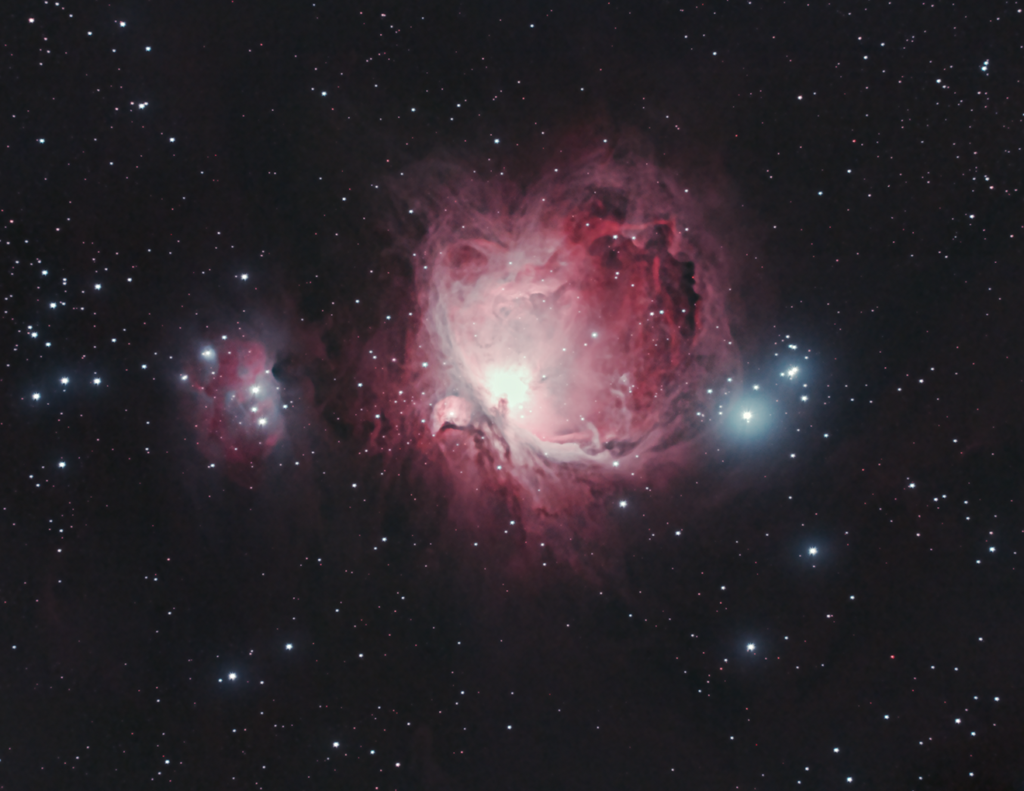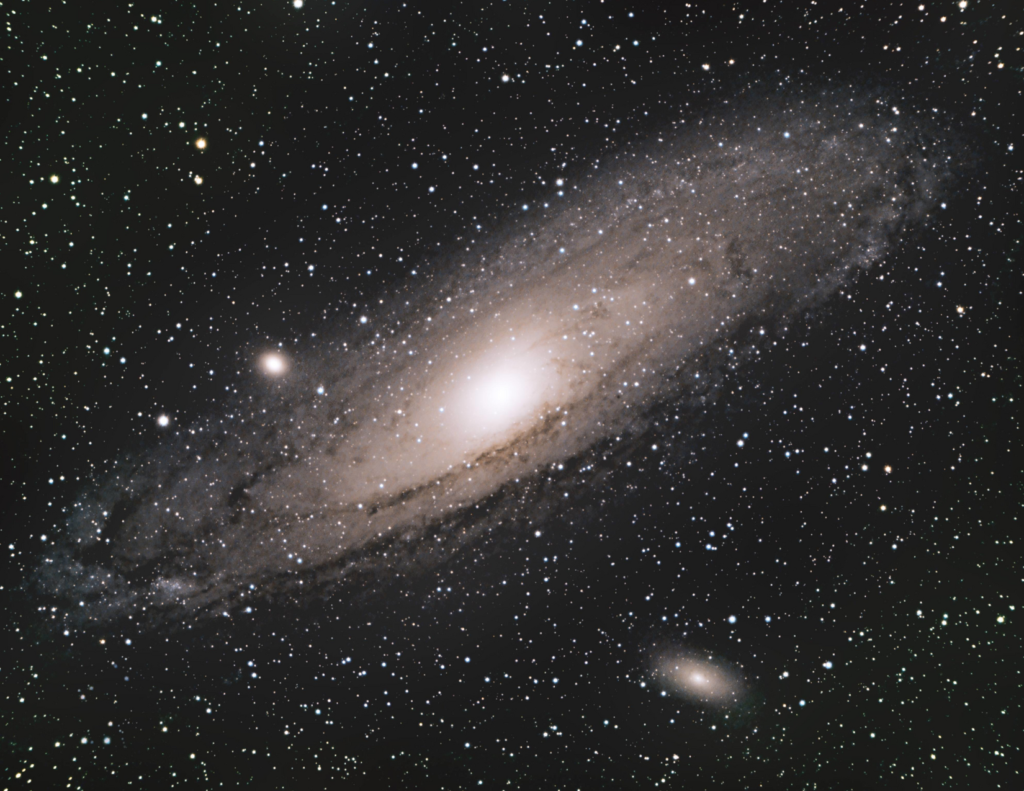The Telescope

The Observatoire du Mont-Mégantic is a renowned astronomical facility nestled atop Mont-Mégantic in Quebec, Canada. Situated within the exceptional natural surroundings of Mont Mégantic National Park, the observatory has earned its place as a hub of scientific discovery, stargazing, and public education.
The observatory, established in 1978, is a collaborative effort between the Université de Montréal, Université Laval, and the Canadian government. It serves as a valuable site for a wide range of astronomical research projects due to its remote location away from urban light pollution, allowing for clear and pristine observations of celestial phenomena.
At the top of the mountain is the observatory, a striking white dome that houses a 1.6-meter Ritchey-Chrétien reflecting telescope.

Inside the OMM, the telescope rests on an equatorial mount, i.e. an orientation aligned with the Earth’s axis of rotation, in order to follow the stars. The light from objects in space that astronomers analyze first reaches the primary mirror. It then bounces back to the secondary mirror, which carries it through the hole in the primary mirror to the instruments installed at the base. In this schematic, the path of light from space entering the telescope is illustrated by yellow lines. Credit: ASTROlab; Guillaume Poulin
Reflecting telescopes, like the iconic Hubble Space Telescope, are remarkable instruments that work using a simple but brilliant principle. Instead of using lenses to bend and focus light, which are very space inefficient, they rely on mirrors!
The heart of a reflecting telescope is the primary mirror, which is a large, curved piece of glass coated with a thin layer of metal. When light from a distant star or galaxy enters the telescope, it strikes this mirror. The mirror reflects the incoming light to a specific point, where a smaller secondary mirror captures it. This secondary mirror then sends the focused light through a small hole in the primary mirror, which is where you place your eye or a camera or instrument.
The magic lies in the shape of the primary mirror. It’s perfectly curved so the incoming light rays, after bouncing off it, converge to form a sharp and magnified image. This is what allows us to see distant celestial objects in such intricate detail. The primary mirror is concave, meaning it curves inward, which helps to focus the light. However, this curved shape can create a type of distortion called spherical aberration, which blurs the image.
To solve this problem, a secondary hyperbolic mirror is placed closer to the primary mirror. The secondary mirror has a different curvature, which counteracts the aberration caused by the primary mirror. This design, defining a Ritchey-Chrétien type telescope, helps eliminate image distortions, resulting in crisp and clear images.
Eyes on the Sky for Over 45 Years
For over 45 years, this legacy telescope has enabled researchers to explore galaxies both near and far, study distant worlds orbiting other stars, and delve into the mysteries of the universe. The facility’s elevation at over 1,100 meters above sea level also contributes to the exceptional quality of observations by reducing the impact of atmospheric distortion.
- The Orion Nebula, undoubtedly one of the best-known celestial objects, is visible throughout the northern winter in the constellation of Orion, close to bright stars such as Betelgeuse and Rigel. This photo was taken by Louis-Simon Guité, accumulating a total of 8 hours of exposure and using a Halpha and OIII filter.
- The Andromeda Galaxy, the closest galaxy to our own Milky Way. This photo was taken by Louis-Simon Guité, a bachelor’s student in physics at the Université de Montréal, for a total of 6 hours of exposure over 2 nights.
One of the observatory’s notable achievements is its significant contributions to the field of exoplanet research. The facility is equipped with specialized instruments designed to detect and study exoplanets – planets that orbit stars beyond our solar system. The Observatoire du Mont-Mégantic has played a role in advancing our understanding of these distant worlds and their potential to host life.
Connecting the Public with the Stars
Beyond its scientific endeavors, the observatory is dedicated to public outreach and education. It hosts various educational programs, workshops, and public events that aim to inspire a fascination for astronomy and science among people of all ages. The ASTROLab museum adjacent to the observatory offers interactive exhibits, displays, and multimedia presentations that engage visitors in the wonders of space.
The unique location of the Observatoire du Mont-Mégantic within a national park makes it an especially attractive place for the public to visit. Visitors not only have the opportunity to engage in astronomy learning but also to experience the natural beauty of the surrounding Quebec landscape. Parc National du Mont-Mégantic is known for its picturesque forest landscapes and is a paradise for outdoor enthusiasts, offering a broad network of hiking trails. But the park is perhaps most famous for its exceptional stargazing opportunities. The observatory’s commitment to environmental stewardship and sustainable practices aligns with its mission to foster a deeper connection between science, nature, and humanity.
In recent years, the observatory has embraced advancements in technology, allowing for more precise and comprehensive observations and the development of cutting edge instruments within it’s associated laboratories. It continues to contribute valuable data to global astronomical research efforts and remains a beacon of knowledge and inspiration for both professional astronomers and the general public in Québec.
The Observatoire du Mont-Mégantic stands as a testament to human curiosity, astronomical research, and the quest to unravel the mysteries of the skies above. Its presence atop Mont-Mégantic not only enriches our understanding of the universe but also reminds us of the profound beauty and interconnectedness of the natural world.



